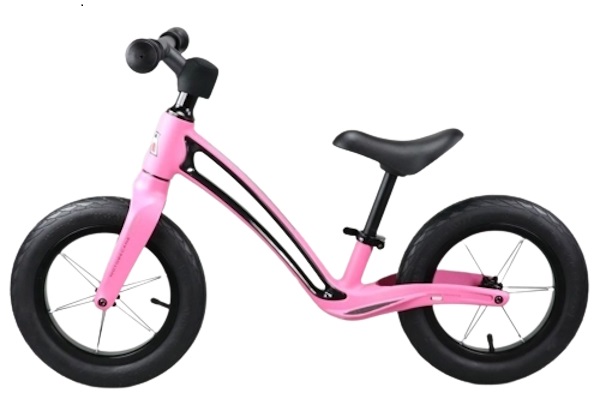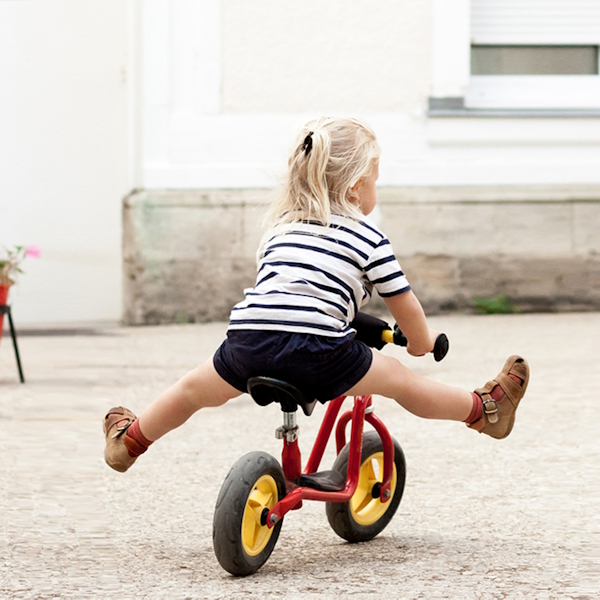
Home > general information > Tips and Guides > Technical guides > Bikes > Accessories and maintenance >
How to choose the right balance bike for your child?
La balance bike is a vehicle with two wheels and handlebars but without pedals, which you move with your feet. It is generally composed largely of wood or steel, it was invented in the XNUMXth century par Karl von Drais and she is considered an ancestor of the bicycle.
Originally intended for adults, it quickly disappeared from circulation when the bicycle began to become popular and became a means of transportation.motion without p motorar Excellency.
The balance bike returned, a few decades ago, as a vehicle for children allowing them to have fun and start learning to ride a bike but above all to learn balance (to hence its name "balance bike" in English-speaking countries), but also the development of reflexes and motor coordination.

What are the technical elements of a balance bike?
The balance bike has neither pedals nor transmission, it is a kind of bike simplified to the extreme: it is however made up of a cycle part of which it is necessary to appreciate the quality:
- Frame (this must provide comfort, flexibility, rigidity, lightness)
- Wheels (rims, bearings, tires, inner tubes...)
- Headset
- Peripheral components (saddle, seat post, handle, handlebars...)
What is the point of a balance bike?
Learning to balance:
This is the main argument of parents who opt for a balance bike. The child will restore balance with the weight of his body and very slight movements of the handlebars. He will be able to ride a bike without difficulty, having acquired balance from an early age.
Development of reflexes:
Using the balance bike stimulates the child and encourages him to manage the movement of his body weight from one leg to the other, and thus balance. This is an opportunity to learn how to manage direction, speed and the transition from stopping to moving. The child will be able to test their own limits and take measured risks, gaining confidence in their physical skills.
Coordination of members:
On a balance bike, the child pushes alternately on one foot then the other; he must also manage the transfer from one support to another and compensate for the imbalance. It stimulates the coordination of your body.
Learning to be independent:
This is the first time that the child has moved away from his parents so quickly: this distancing is something new for his age, who was used to it until here to move at a slow pace. And for parents? It is also the time to prepare for the beginnings of autonomy, which then continues with the use of the bicycle.
The balance bike recommended in National Education programs!
In September 2015, the balance bike appeared in school programs for kindergarten (Cycle 1): its use is recommended to develop the child's balance.
How to choose the right balance bike?
Which EU standard for the balance bike
It is essential to ensure at the time of purchase that the balance bike, classified as a toy, complies with the European standard EN71. This standard put in place par Europe concerns toys imported or manufactured in the European Union.
Size of a balance bike
The size of the balance bike is a very important criterion. It is difficult to ride a balance bike that is not the right size; the child must have the right position and be comfortably seated on the saddle with their legs half bent. Your feet must touch the ground to give momentum and stabilize the bike/child pair.
The weight of a balance bike
It is important that the balance bike is light so that the child can handle it easily and without having to resort to external help. The weight of a balance bike is generally between 3.5 kg and 4 kg.
A balance bike with or without brakes?
At the start of learning, the child uses his balance bike carefully. Once familiar with the object, he gains confidence and speed. The brake quickly becomes an essential safety element. It should be noted that adding a braking system to a balance bike in a second step is not always easy. To choose, we advise you to opt for a balance bike already equipped with brakes!
The materials
One of the differentiating elements on a balance bike will be the material used in the construction of the frame. As on an adult bike, the material will play a role.
- Made of wood: the wooden balance bike refers to the original balance bike. It will be solid and scalable.
- Metal: the metal balance bike (mainly steel or aluminum) must be very light to optimize the maneuverability of the bike.
- Plastic: the plastic balance bike is the lightest, it is considered more of a toy for the child than an object of mobility.
- Made of magnesium: magnesium is 33% lighter than aluminum, which makes the balance bike easier to handle for the child and easier to transportar the parent. It is as robust as steel and 3x more resistant than plastic, which makes the balance bike durable over time but also 100% recyclable. It also facilitates the absorption of irregularities on the road, it acts as a shock absorber and therefore makes driving easier.

What are the risks with a balance bike?
The advantage with a balance bike is that a child who is not yet able to use it (par lack of muscle tone or par apprehension), will not be able to hold her between his legs. Only once he feels confident and capable enough will he be able to operate the balance bike. This is how the child truly progresses at his own pace.
As on a scooter or a bicycle, the main risk is linked to cars. It is absolutely necessary to ensure that the child rides in completely safe places (cycle path, pedestrian streets, public garden...). The other risk is speed. If the child is riding on flat ground or on a very slight slope, the balance bike will go at a low speed. Par on the other hand, on a steep slope, the balance bike can quickly pick up speed without the child being able to stop.
What protections with a balance bike?
Le Headphones is absolutely essential: from the first turns of the wheel, if only so that the child has the reflex to systematically equip himself before using his two-wheeler: a Once this reflex is acquired, it’s for life!
Pants are very useful to protect your knees. Par However, no other protection (elbow pads or knee pads) is essential on a balance bike.
In summary, purchasing a balance bike is not trivial. He must take into consideration several criteria such as the size and weight of the balance bike. These two points determine the handling par your child: if he or she doesn't have any difficulty using it, you're a winner!
The model must also meet the expectations of parents, who are more attentive to safety, the quality of the finish, materials or aesthetics. So be vigilant on all these points in order to allow your child to best appreciate the practice of the balance bike for their development and pleasure.






